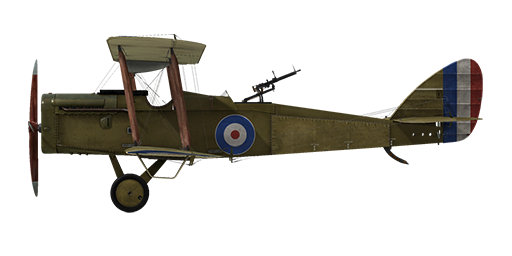il2
Airco D.H.4

Description
Designed by Geoffrey de Havilland to be a two-seat light bomber powered by a BHP engine. First prototype flew in August 1916, but as the BHP engine proved to be weak it required a major redesign and DH.4 was adapted to be equipped with a Rolls Royce Eagle engine. First order for 50 planes powered by Eagle III engine (250hp) was placed at the end of 1916.
Basically an all-wooden construction tractor biplane, Airplane armament consisted of one forward-firing Vickers synchronized machine gun and one or two Lewis guns on the Scarff ring mount at the observer position. It could carry up to 460 pounds of bombs on external racks on wings or central position.
Due to shortages of Rolls Royce engines the production airplanes were also fitted with BHP (230hp), RAF3A (200hp), the Siddeley Puma (230hp) and the 260hp Fiat, yet none of the alternative powered DH.4's could match the Rolls Royce powered machines. First DH.4 in frontline service were supplied to No.55 squadron on March 1917; it was the first RFC squadron fully equipped with this type. Till the end of 1917, a total of 6 squadrons were equipped with DH.4's. It also was used by RNAS squadrons for naval operations for recon and anti-submarine use.
Reported to be pleasant to fly and easy to operate, the crews loved it because of its speed and maneuverability (the only “flaw” noted by its crews was the fuel tank placed between pilot and observer cockpits which caused communication problems between them). Due to its abilities, it was often used without fighter cover as its speed and good altitude performance allowed it to survive. Mostly used as a light day-bomber, it also could carry radio equipment for artillery observation duties and camera equipment for photo-reconnaissance missions.
Produced by Airco, F.W. Berwick and Co, Glendower Aircraft Company, Palladium Autocars, Vulcan Motor and Engineering, and the Westland Aircraft Works in the UK, a total of 1,449 aircraft were built in the UK for the RFC and RNAS through the end of the war.
Engine: V-type 12 cyl. Rolls Royce Eagle VII
Power: 275 hp (320hp at 1800 RPM)
Dimensions:
Height: 3100 mm
Length: 9200 mm
Wing span: 12916 mm
Wing surface: 40 sq.m
Weight:
Empty: 1088 kg
Fuel capacity: 249 liters
Oil capacity: 27.3 liters
Takeoff without bombload: 1588 kg
Speed (IAS), without bombload:
sea level - 200 km/h
1000 - 189 km/h
2000 - 178 km/h
3000 - 166 km/h
4000 - 154 km/h
5000 - 140 km/h
Climb rate, full fuel load, no bombs:
1000 m - 3 min. 23 sec.
2000 m - 7 min. 7 sec.
3000 m - 11 min. 47 sec.
4000 m - 17 min. 52 sec.
5000 m - 27 min.
Service ceiling: 6800 m
Endurance 3 h.
Armament:
Forward firing: 1 x Vickers Mk.I 7.69 mm, 500 rounds per barrel
Tail upper position: 1 x Lewis 7.69 mm, 8 drums with 97 rounds each
Bomb load variations:
12 x 20lb (109 kg)
8 x 20lb + 2 x 112lb (175 kg)
4 x 112lb (203.4 kg)
2 x 112lb (101.7 kg)
2 x 230lb (208.8 kg)
208.8 kg in total
References
1) Air Board Data Charts, 1917.
2) Notes on the prediction and analysis of airplane performance, reports and memoranda no.474, may 1918, tables no. 10 and 11.
3) Windsock Datafile Special - Airco DH.4 Vol.1, by J.M. Bruce.
4) Rolls Royce engine charts, 1917.
5) WWI Aeroplanes data, by J.M. Bruce.
6) Various NACA reports.
Modifications
Aldis
Aldis Refractor-type Collimator Sight
Additional mass: 2 kg
Twin forward Vickers
Twin fixed forward firing Vickers guns.
Ammo: 1000 of 7.69mm rounds (500 rounds for each gun)
Projectile weight: 11 g
Muzzle velocity: 745 m/s
Rate of fire: 750 rpm
Guns weight: 13 kg (w/o ammo drums)
Mounts weight: 4 kg
Ammo weight: 21 kg
Total weight: 38 kg
Cooper / H.E.R.L. / H.E.R.F.C. bombs
Up to 12 x 11 kg (24 lb) General Purpose Bombs
Additional mass: 167 kg
Ammunition mass: 131 kg
Racks mass: 36 kg
Estimated speed loss before drop: 7 km/h
Estimated speed loss after drop: 3 km/h
Up to 4 x 51 kg (112 lb) H.E.R.L. General Purpose Bombs
Additional mass: 227 kg
Ammunition mass: 204 kg
Racks mass: 24 kg
Estimated speed loss before drop: 8 km/h
Estimated speed loss after drop: 4 km/h
Up to 2 x 104 kg (230 lb) H.E.R.F.C. General Purpose Bombs
Additional mass: 224 kg
Ammunition mass: 208 kg
Racks mass: 16 kg
Estimated speed loss before drop: 5 km/h
Estimated speed loss after drop: 3 km/h
Fuel Gauge
Needle Scale fuel level Gauge (0-30 Gallons)
Additional mass: 1 kg
Twin Lewis MG turret
Scarff ring turret with twin Lewis MG
Ammo: 776 of 7.69mm rounds (8 drums with 97 rounds in each)
Projectile weight: 11 g
Muzzle velocity: 745 m/s
Rate of fire: 550 rpm
Guns weight: 15 kg (w/o ammo drums)
Mount weight: 12 kg
Ammo weight: 32 kg
Total weight: 59 kg
Estimated speed loss: 2 km/h
Twin Lewis Overwing
Two overwing mounted additional fixed Lewis machineguns.
Ammo: 194 of 7.69mm rounds (2 drums with 97 rounds in each)
Projectile weight: 11 g
Muzzle velocity: 745 m/s
Rate of fire: 550 rpm
Guns weight: 15 kg (w/o ammo drums)
Mounts weight: 6 kg
Ammo weight: 10 kg
Total weight: 31 kg
Estimated speed loss: 5 km/h
Cockpit light
Cockpit illumination lamp for night sorties
Additional mass: 1 kg
Radio
Radio transmitter
Additional mass: 10 kg
Camera
Camera for taking aerial photographs
Additional mass: 10 kg